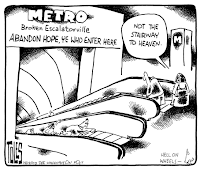
 First-time visitors to our nation’s capital, including many Glenn Fellows, routinely fall in love with the Washington Metro. It happened to me when I first rode the embryonic subway system in 1976. In those days Metro consisted of just a handful of stops on the Red and Blue Lines. But it was clean and fast, and it seemed to bespeak confidence in the public sector. With its classical allusions, Metro seemed a natural extension of L’Enfant’s ambitious city plan.
First-time visitors to our nation’s capital, including many Glenn Fellows, routinely fall in love with the Washington Metro. It happened to me when I first rode the embryonic subway system in 1976. In those days Metro consisted of just a handful of stops on the Red and Blue Lines. But it was clean and fast, and it seemed to bespeak confidence in the public sector. With its classical allusions, Metro seemed a natural extension of L’Enfant’s ambitious city plan.I was an aficionado in the early days. No more. The quirks that once seemed so charming gradually became annoying—and, ultimately, infuriating. Every regular Metro rider has his or her pet peeve.
For me, it’s the chronic problem of out-of-service escalators. Escalators are absolutely essential to Metro’s basic design, and yet they have been unreliable from Day One. We know this thanks to Zachary M. Schrag, author of The Great Society Subway (Baltimore: Johns Hopkins University Press, 2006), the authoritative history of the Washington Metro. Let Schrag pick up the story here:
Harry Weese [Metro’s chief architect] and his team had originally planned all vertical movement by escalator. In the course of the 1970s cost-cutting, some escalators were replaced with granite stairs, but every station entrance and mezzanine had at least two escalators. . . .
The fundamental problem with the escalators is . . . that they are complicated machines with hundreds of moving parts, run for nineteen hours a day and stepped on by their users. Like helicopters and photocopiers, they are inherently maintenance-intensive. As the architects planned the stations, the nation’s leading escalator manufacturers warned them to expect each escalator to be out of service for a ten- to twelve-day stretch each year. Based on this advice, the architects made room for three escalators at most street entrances, so that two could provide down and up service while the third was repaired. But a spare escalator cannot guarantee adequate maintenance. WMATA has struggled to find enough skilled mechanics to work twenty-four-hour shifts, and it has lacked funds to overhaul aging escalators according to schedule. Unsurprisingly, deferred maintenance has resulted in breakdowns, with up to one out of every five escalators out of service on any given day (Schrag, pp. 246-247).
Your faithful blogger respectfully disputes Schrag’s one-in-five estimate. I have been silently documenting Metro’s escalator performance for 25 years and have found that roughly one in three escalators are out of service on any given day.
Schrag is right that repair of a Metro escalator is a major undertaking. At Braddock Road, the Metro station in Alexandria that I know best, there are two escalators, one elevator, and no staircases. A few years ago the escalators—first one, then the other—underwent a complete overhaul. The job was supposed to take six months for each escalator. It took seven months, in fact, which meant that for a total of fourteen months riders had to endure two-way foot traffic twice a day on the escalator not then undergoing repair. You can build a McMansion is less time. Hell, the Phoenix Project that rebuilt the Pentagon after the attack of September 11, 2001, was faster than that.

No comments:
Post a Comment